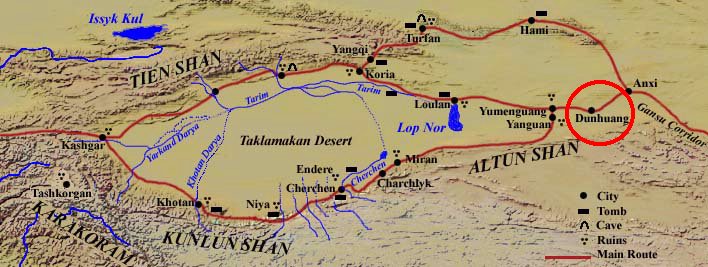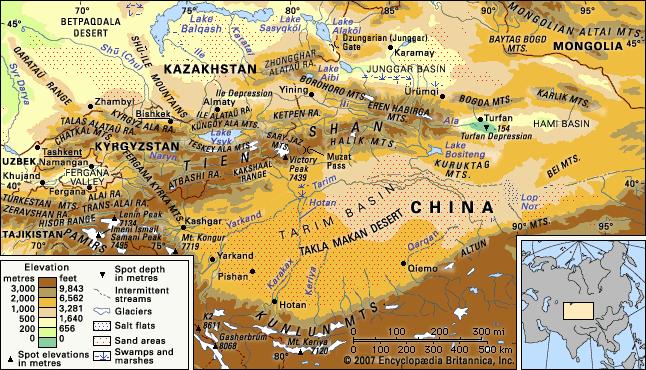5 Great Ancient Mysteries of China
/China is one of the world’s four ancient civilizations and considered the oldest civilization with an unbroken history up to today's modern era. Though Chinese history is unrivaled in its documentation, and its ancient origins have been extensively studied by various experts in science, history and archaeology, China – as a cradle of human civilization – remains a place full of secrets.
Moreover, so, let us examine five of the greatest ancient mysteries that China has to offer.
1. Ancient City Under Fuxian Lake
Spanning an area of 212 square kilometers, the Fuxian Lake stretches out through Chenjiang, Jianchuan and Huaning Counties in Yunnan Province. It is ranked as the third-largest lake in Yunnan, and also the deepest lake in the province. As it is 155 meters deep at its greatest depth, the Fuxian Lake is also the third-deepest freshwater lake in all of China.
The Fuxian Lake is known for its unique fauna and many endemic species, but beyond this is a mystery that lies scattered on the lake’s unexplored bottom. According to an ancient local legend, a city-like silhouette under the lake can be seen on a beautiful calm day from the mountains nearby. To confirm if there is a hidden city in the deep waters of the lake, a Chinese submarine archaeology team stationed in the area conducted surveys in the Fuxian Lake.
In 2001, they discovered earthenware and stonework beneath the lake, covering an area of approximately 2.4 to 2.7 square kilometers. Carbon dating of some shells attached to the blocks confirmed that the site was 1750 years old, which meant that it had existed around 257 CE and sunk during the Han period. It is believed that the ancient unidentified structure of the under-lake construction could represent the remains of the ancient Dian Kingdom. The Dian Kingdom is an ancient country with a high level of civilization which mysteriously disappeared after 86 BC.
As for how the ancient civilization ended up at the bottom of the lake, some say that the ancient kingdom slid into the lake during an earthquake. Nevertheless, there are various legends involving the Fuxian Lake which has endured for more than 1,000 years that have yet to be verified. Since it is a huge body of water that remains largely unexplored, the credibility of these compelling mysteries may remain unconfirmed in the foreseeable future.
2. Mystery of the Huashan Caves
Located in the eastern suburbs of Tunxi district in the Anhui province city of Huangshan, the Huashan Caves are steeped in ancient, mysterious legends. Each ranging from 10 to 20 meters in height, the Huashan Caves, were manually chiseled more than 1,700 years ago. Stone columns, which vary in shapes support the caves’ ceilings. Altogether, 36 chambers were found among the Huashan Hills. Some of these chambers are filled with water, while some are two-story chambers. It's neatly chiseled walls and roofs, the big pillars and stone stairs, indicated that men excavated the caves.
Out of all the 36 caves, the biggest of them all is the Qingliang Cave, which is also referred to as the “Underground Palace” because of its scale and magnificent layout. This cave has a total length of 170 meters and an area of 12,600 square meters, and digging out the cave could have originally produced at least 50,000 cubic meters of stone. Inside the cave, a stone bridge above an underground river can be found, and stone paths lead to different halls.
The Huashan Mountain has the biggest, most content-rich, and best-preserved ancient rock carvings ever discovered in China. They stretch 200 meters long and 40 meters high containing over 1,800 images. Carbon dating suggests the oldest ones are 16,000 years old with the youngest still 690 years old.
Since no historical records reveal why the ancient people dug the Huashan Caves, some people believe the caves were mined for many stones needed to build a nearby town, to station troops, or maybe as Imperial tombs eventually abandoned. Despite all these guesses, the true reason creating this elaborate site remains an enduring mystery unanswered by today's man.
3. The Mystery of the Mystical Yellow Emperor
Ancient Chinese records speak of an extraordinary being, described as a god-like king and the “son of heaven.” This wise and powerful being was Huang-Di or Yellow Emperor. He was a legendary ruler who is said to have lived for over one hundred years around 3,000 B.C. Cited for being instrumental in developing the Chinese society and for being the founder of Chinese civilization, the Yellow Emperor created Chinese medicine, various religious practices, and mechanical inventions.
However, aside from these achievements, there are several other reasons why the legendary Yellow Emperor was special and different. Huang-Di possessed advanced technology and extensive knowledge of the stars and the heavens. It was even believed that he descended on Earth in a “thunderclap on a clear day” when he began his reign. It has also been said that he had the ability to summon a metal-scaled dragon. He also kept in his possession a magical chariot known as Changhuan, which could take the Yellow Emperor to any part of his kingdom at fantastic speed.
Given the nature of the Yellow Emperor’s backstory, there are those who have speculated that Huang-Di was actually an extra-terrestrial who landed in the land of ancient China five thousand years ago and ruled over the people who lived in the area at the time. Whether this is true or not, it cannot be denied that the Yellow Emperor is a very important figure in ancient China’s legends and history.
4. Ancient World Buried Under the Taklamakan Desert
Ancient people believed that once you entered the Taklamakan desert, there was no getting out of it. The Taklamakan desert is the largest desert in China, and it is considered to be the world’s second largest shifting-sand desert, covering a massive area of over 33,700 square kilometers.
A long, long time ago, houses and temples were built amid the vast space of the “Sea of Death.” However, today, everything – including precious ancient relics – are hidden deep under the sand. Over the years, archaeologists have begun to discover some of the secrets that have been hidden in this mysterious region.
Aside from its vital role in trade and commerce back when Silk Road connected various traders from the East and the West, some believe that an entire ancient world is hidden beneath the sand of the Taklamakan Desert. Remains of houses, temples, and the ancient city of Loulan were found buried under the sand, and corpses dating back nearly 4,000 years were also discovered in the area.
In the late 1980s, several well-preserved mummies estimated to be at least 3000 years old were also discovered in the Taklamakan desert. These well-preserved corpses revealed that these people once had long reddish-blond hair and European features. Neither did they appear to be the ancestors of the modern-day Chinese people. Moreover, so, some experts in archaeology now believe that these mummies were once citizens of an ancient civilization existing at the crossroads between Europe and China.
While this seems to be a big leap in logic, more surprising discoveries are expected to as archaeologists continue to investigate the mysterious and dangerous desert, which could support or refute the hypothesis of a secret ancient world hidden beneath the sand.
5. The Great Pyramid of China
The story behind the Great Pyramid of China is beyond interesting. For years, the Chinese government has allegedly hindered proper and extensive studies to be performed on the numerous pyramids located near the city of Xi-an. The pyramids are believed to be over 8,000 years old, and one of them is said to be much larger than the world-famous Great Pyramid of Giza.
The knowledge of the existence of several pyramids in China came to popular attention sometime after the Second World War. Many of the stories focused on the “Great White Pyramid” or the Maoling, which is the tomb of Emperor Wu of the Han Dynasty (156-87 BCE) located in Xingping, Shaanxi Province.
During World War II, U.S. Army Air Corps pilot James Gaussman is said to have seen a white jewel-topped pyramid during his flight between India and China. Fascinated by what he saw, he decided to take several photographs, which he later submitted along with a detailed report to his superiors as soon as he returned to base. Colonel Maurice Sheahan, the Far Eastern director of the Trans World Airline, told a similar eyewitness account, which was published in the March 28, 1947, edition of The New York Times. Over the years, numerous images of the alleged gigantic pyramids in China have been taken by pilots and satellites, providing further confirmation of the existence of these mysterious structures in Asia.
Given the immense knowledge of geometry and mathematics required to build these pyramids, a glaring question has been raised: Who were the mysterious people that built these Chinese pyramids?
There are those who speculate that the Great Pyramid, as well as the other pyramids standing in the area, were actually built by extraterrestrial beings. According to reports, several European excursions took samples of the objects and metals around these pyramids. Analysis showed a fascinating detail about them: the metallic materials present at the Pyramids have yet to be accurately identified until now, since these metals are made out of materials that are currently unknown to modern science.
Aside from the five things we have just discussed, there are several other puzzling and strange ancient places and objects in this Far East civilization that are still shrouded in mystery. Many of these places and artifacts are unknown to the Chinese themselves, but should the time come that their hidden mysteries are completely unraveled, they have the potential to rewrite history as we know it.
Sources:
http://www.messagetoeagle.com/10-great-ancient-mysteries-of-china/
http://www.ancientpages.com/2015/06/13/underwater-city-unveiling-the-secrets-at-the-bottom-of-fuxian-lake/
http://www.chinadaily.com.cn/m/anhui/travel/2011-05/10/content_12483078.htm
http://www.messagetoeagle.com/unanswered-questions-related-to-the-mysterious-huashan-caves/
http://www.ancientpages.com/2015/09/21/unravelling-mystery-yellow-emperor-connection-regulus/
https://www.ufoinsight.com/worldly-mysteries-chinas-yellow-emperor/
http://www.ancientpages.com/2014/05/21/secret-ancient-world-buried-under-the-vast-takla-makan-desert/
http://www.ancient-code.com/the-great-pyramid-of-china-the-largest-and-oldest-pyramid-on-the-planet/
http://www.ancientpages.com/2015/10/10/mysterious-great-pyramid-of-china-almost-totally-unknown-even-to-most-chinese/
https://en.wikipedia.org/wiki/Chinese_pyramids#Sensational_claims























